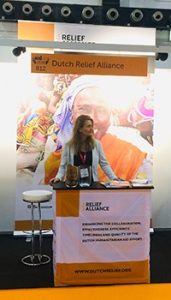THE DUTCH RELIEF ALLIANCE
Aid organisations working in an alliance are able to enhance the effectiveness, timeliness, reach and quality of humanitarian aid efforts. But how does this work in practice? Find out in our report from the ‘Insights into the Working of a Humanitarian Coalition’ event – held last week at AidEx in Brussels.
Lars Faber, Senior Programme Officer at the Humanitarian Department of the Netherlands Ministry of Foreign Affairs, outlined the considerations behind the Ministry’s support of the Dutch Relief Alliance (DRA). “By working together as an alliance, aid organisations are able to increase their effectiveness,” he said.
The DRA was established in 2015 in consultation with the Dutch government in order to provide rapid and effective emergency assistance to victims of international humanitarian crises. “Thanks to the alliance, efforts of civil society organisations affiliated with the DRA have increased impact in terms of scale”, Faber said.
“Furthermore, the impact of innovation increases: by sharing expertise – and focusing on innovation – new solutions are created to meet people’s needs.”
The Netherlands Ministry of Foreign Affairs has committed multi-annual funding to the DRA of €60 million – but its role is not that of a traditional donor. “It’s a partnership instead of a donor recipient relationship,” Faber explained.
“Trust is the key word. We make sure aid organisations can rely on multi-annual funding, so they can plan ahead. We also avoid earmarking of funding and top-down decisions; instead the DRA has developed a transparent mechanism which puts responsibility at the right level.”
 The added value of the DRA is particularly felt on the ground where joint humanitarian responses are active, according to Elselijn Mulder (left). Elselijn is Project Lead Humanitarian Aid at Oxfam Novib, and works on several DRA-funded Joint Responses, including those in Bangladesh and Afghanistan.
The added value of the DRA is particularly felt on the ground where joint humanitarian responses are active, according to Elselijn Mulder (left). Elselijn is Project Lead Humanitarian Aid at Oxfam Novib, and works on several DRA-funded Joint Responses, including those in Bangladesh and Afghanistan.
“Because funding is available quickly, we are able to bridge the funding gap and can respond directly with confidence,” Mulder explains. “Particularly in protracted crises, such as Afghanistan, efficiency is higher because of our collaboration. One example is that we offer local security trainings that are open for staff and partners, instead of each individual organisation organising these trainings. And we jointly undertake monitoring visits to learn from each other.”
Localisation is one of the top priorities of the DRA partners, Laurens den Dulk, programme officer Disaster Management for ICCO & Kerk in Actie said at the Brussels event. “The DRA has committed itself to surpass the goals of the Grand Bargain. We aim at funding of local actors to be not 25 per cent but 35 per cent by the year 2021.”
Laurens admits this is an ambitious goal – but he insists it is achievable. “We do our best not to discuss localisation in The Netherlands, or in Brussels, but to discuss it and put it into practice in the countries where the emergencies actually happen and where local responders are the frontrunners,” he explains. “Because they are at the heart of the response.”
Richard Kooge, Manager Business Development and Innovation at CARE Nederland, and vice-chair of the DRA Innovation Working Group, closed the event with a presentation that underlined the added value of joint work when it comes to innovation.
“As a Working Group we facilitate an environment for piloting, scaling up and implementing innovation,” Kooge said. “This way we ensure that aid organisations are at the forefront of solutions to deliver high quality humanitarian assistance”. He also gave examples of the winning proposals of the first innovation Call for Proposals, such as the bracelets that women in crisis areas can use to protect themselves.
“Thanks to the sustained multi-annual funding from The Netherlands Ministry of Foreign Affairs, the Dutch Relief Alliance will continue its collaborative work, and, in the years to come, millions more people will receive much needed humanitarian assistance,” concluded Nok van de Langenberg, Chair Dutch Relief Alliance and Head of Humanitarian Action and Safety and Security Coordinator at CARE Nederland.
AidEx is the leading global event for professionals in humanitarian aid and international development. AidEx welcomes professionals from the sector and over 2,500 people attend each year from UN Agencies, the EU, Red Cross and Red Crescent Societies, local and international NGOs, government and the private sector.
It was the first time the Dutch Relief Alliance presented itself for such a big international community with a presentation and an exhibition stand. “It was a great opportunity to build new relationships and showcase the DRA mechanism to other countries,” said van de Langenberg.
THE DUTCH RELIEF ALLIANCE
CARE Nederland (chair)
Parkstraat 19
2514 JD Den Haag
The Netherlands
E: office@dutchrelief.org